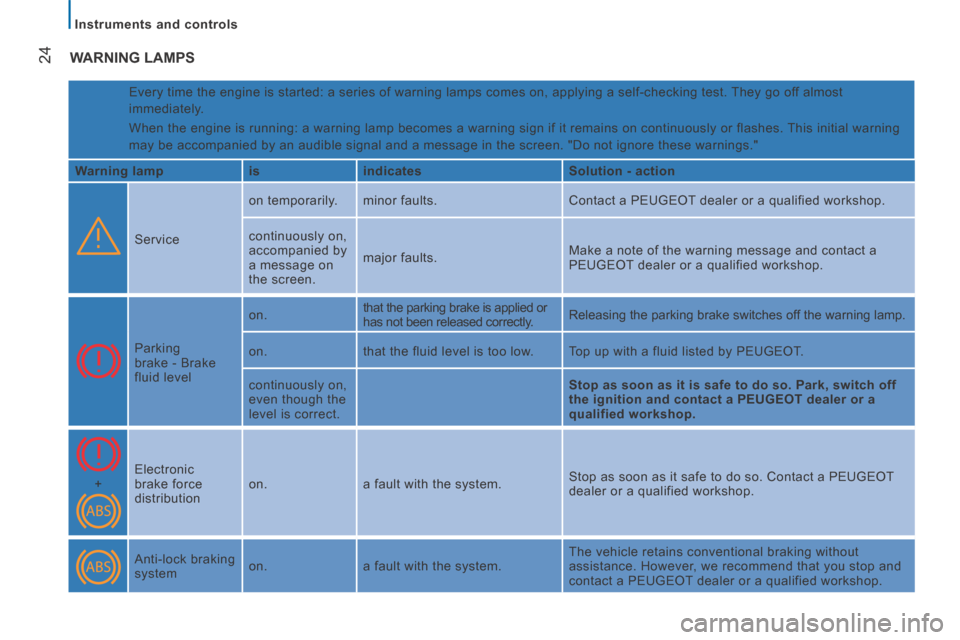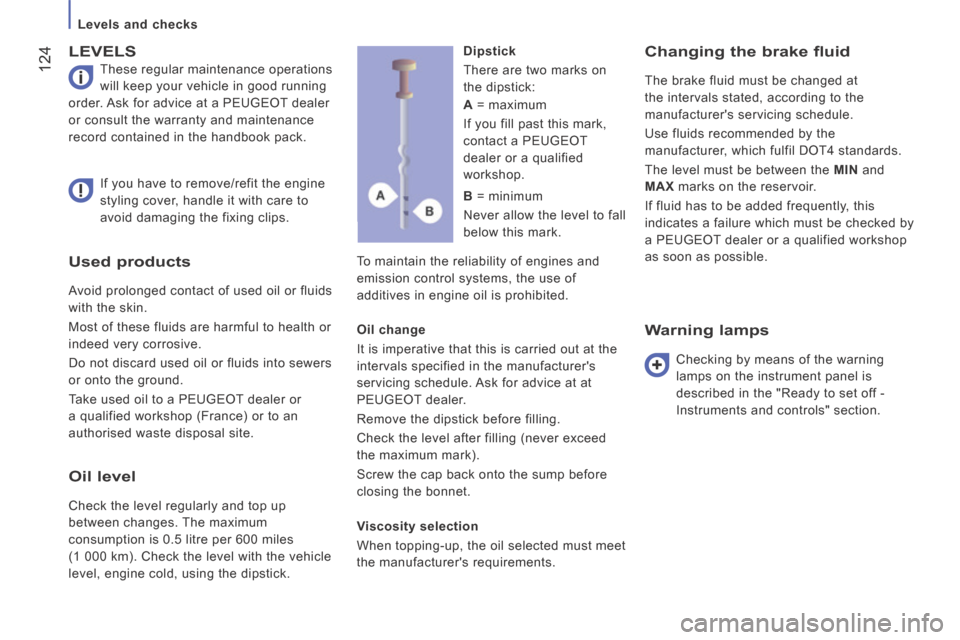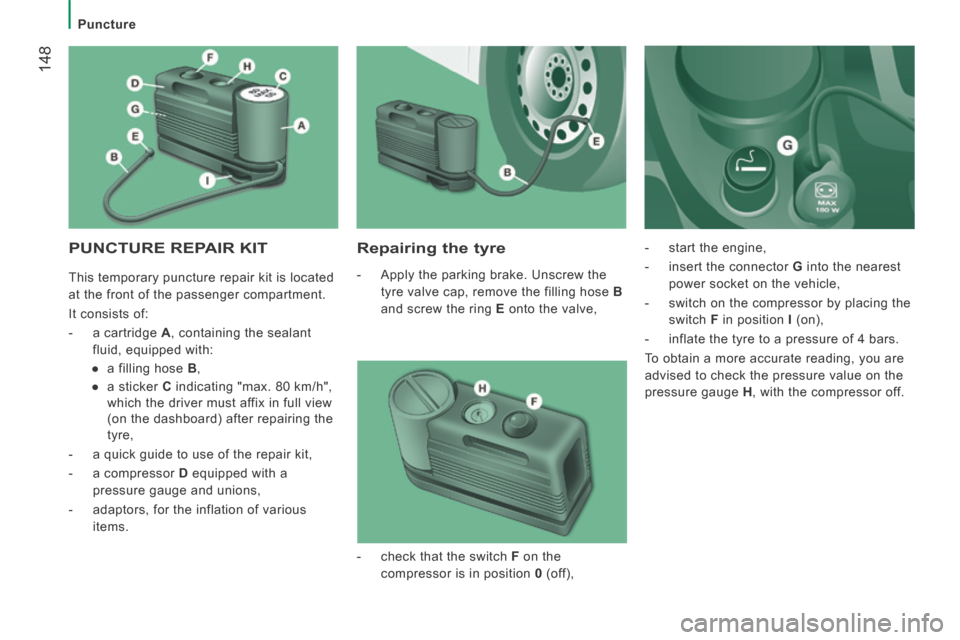Page 26 of 240

24
Instruments and controls
WARNING LAMPS
Every time the engine is started: a series of warning lamps comes on, ap\
plying a self-checking test. They go off almost
immediately.
When the engine is running: a warning lamp becomes a warning sign if it \
remains on continuously or flashes. This initial warning
may be accompanied by an audible signal and a message in the screen. "Do\
not ignore these warnings."
Warning lamp is indicates Solution - action
Service on temporarily.
minor faults. Contact a PEUGEOT dealer or a qualified workshop.
continuously on,
accompanied by
a message on
the screen. major faults.
Make a note of the warning message and contact a
PEUGEOT dealer or a qualified workshop.
Parking
brake - Brake
fluid level on.
that the parking brake is applied or
has not been released correctly. Releasing the parking brake switches off the warning lamp.
on. that the fluid level is too low. Top up with a fluid listed by PEUGEOT.
continuously on,
even though the
level is correct. Stop as soon as it is safe to do so. Park, switch off
the ignition and contact a PEUGEOT dealer or a
qualified workshop.
+ Electronic
brake force
distribution on.
a fault with the system. Stop as soon as it safe to do so. Contact a PEUGEOT
dealer or a qualified workshop.
Anti-lock braking
system on.
a fault with the system. The vehicle retains conventional braking without
assistance. However, we recommend that you stop and
contact a PEUGEOT dealer or a qualified workshop.
Page 125 of 240
123
7
Under the bonnet
CHECKS
1. Windscreen/headlamp wash fluid reservoir.
2. Fusebox.
3. Coolant reservoir.
4. Brake and clutch fluid reservoir.
5. Air filter. 6. Dipstick.
2.2 Iitre HDi engine
7. Engine oil filler cap.
2.2 Iitre HDi engine
8. Power steering fluid reservoir.
Battery connections :
+ Positive terminal.
- Negative terminal (earth).
UNDER THE BONNET - DIESEL ENGINES
Page 126 of 240

124
Levels and checks
Used products
Avoid prolonged contact of used oil or fluids
with the skin.
Most of these fluids are harmful to health or
indeed very corrosive.
Do not discard used oil or fluids into sewers
or onto the ground.
Take used oil to a PEUGEOT dealer or
a qualified workshop (France) or to an
authorised waste disposal site.
LEVELS
These regular maintenance operations
will keep your vehicle in good running
order. Ask for advice at a PEUGEOT dealer
or consult the warranty and maintenance
record contained in the handbook pack.
To maintain the reliability of engines and
emission control systems, the use of
additives in engine oil is prohibited.
Changing the brake fluid
The brake fluid must be changed at
the intervals stated, according to the
manufacturer's servicing schedule.
Use fluids recommended by the
manufacturer, which fulfil DOT4 standards.
The level must be between the MIN and
MAX marks on the reservoir.
If fluid has to be added frequently, this
indicates a failure which must be checked by
a PEUGEOT dealer or a qualified workshop
as soon as possible.
If you have to remove/refit the engine
styling cover, handle it with care to
avoid damaging the fixing clips. Dipstick
There are two marks on
the dipstick:
Oil change
It is imperative that this is carried out at the
intervals specified in the manufacturer's
servicing schedule. Ask for advice at at
PEUGEOT dealer.
Remove the dipstick before filling.
Check the level after filling (never exceed
the maximum mark).
Screw the cap back onto the sump before
closing the bonnet.
Viscosity selection
When topping-up, the oil selected must meet
the manufacturer's requirements.
Warning lamps
Checking by means of the warning
lamps on the instrument panel is
described in the "Ready to set off -
Instruments and controls" section.
A
= maximum
If you fill past this mark,
contact a PEUGEOT
dealer or a qualified
workshop.
B = minimum
Never allow the level to fall
below this mark.
Oil level
Check the level regularly and top up
between changes. The maximum
consumption is 0.5 litre per 600 miles
(1 000 km). Check the level with the vehicle
level, engine cold, using the dipstick.
Page 150 of 240

148
Puncture
PUNCTURE REPAIR KIT Repairing the tyre
- Apply the parking brake. Unscrew the tyre valve cap, remove the filling hose B
and screw the ring E onto the valve, - start the engine,
- insert the connector G
into the nearest
power socket on the vehicle,
- switch on the compressor by placing the switch F in position I (on),
- inflate the tyre to a pressure of 4 bars.
To obtain a more accurate reading, you are
advised to check the pressure value on the
pressure gauge H , with the compressor off.
- check that the switch F on the
compressor is in position 0 (off),
This temporary puncture repair kit is located
at the front of the passenger compartment.
It consists of:
- a cartridge A
, containing the sealant
fluid, equipped with:
● a filling hose B ,
● a sticker C indicating "max. 80 km/h",
which the driver must affix in full view
(on the dashboard) after repairing the
tyre,
- a quick guide to use of the repair kit,
- a compressor D equipped with a
pressure gauge and unions,
- adaptors, for the inflation of various items.